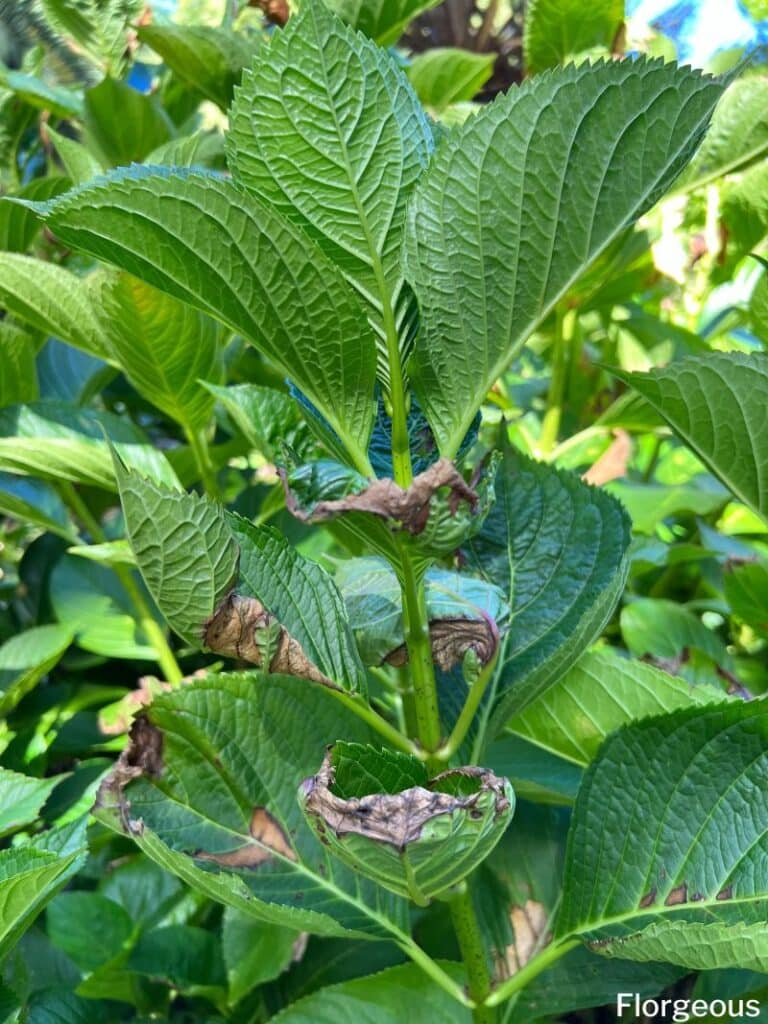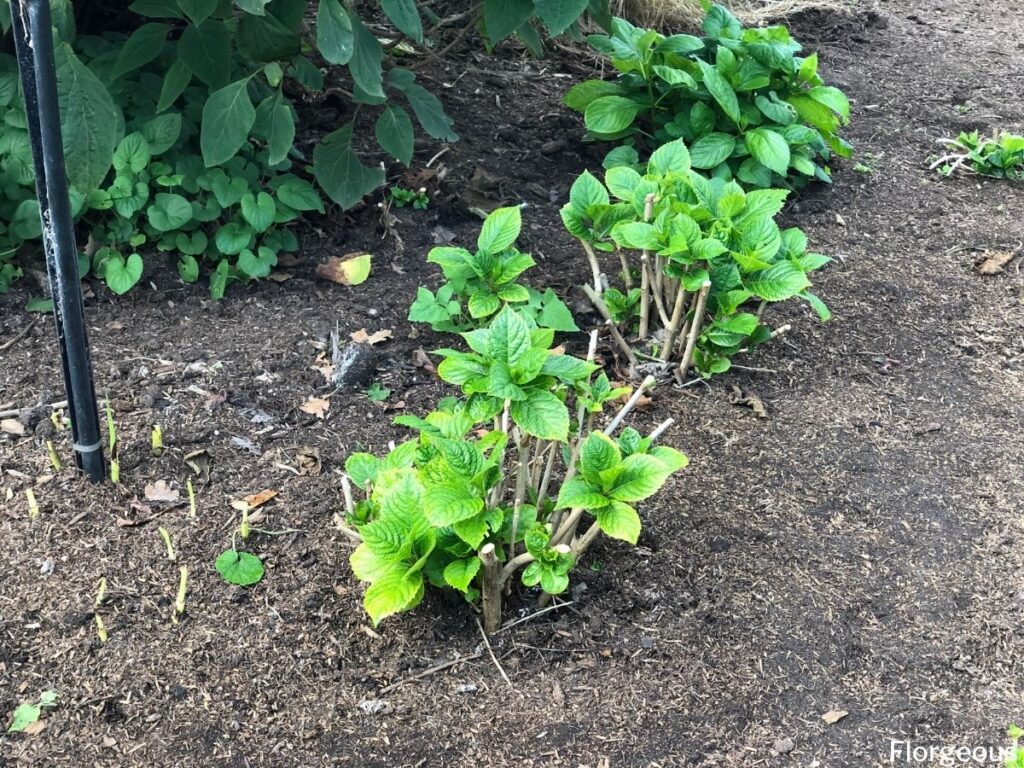Most hydrangea diseases are easily prevented – but if you find your plants looking anything other than green and lush, you might be wondering what you did wrong.
The reality is that many common illnesses can come on suddenly without warning. While most won’t kill your shrubs outright, it is important to be aware of the most common issues so that you can take appropriate steps to ward them off before they become problematic.
Here are common diseases and problems you need to know when growing hydrangea plants:
What Does an Unhealthy Hydrangea Look Like?
Hydrangeas are known for their hardiness and they have few serious disease problems that can affect their health. There are many, however, that can cause severe cosmetic damage.
If your hydrangea is infected with some sort of illness, the most common symptoms are those that affect the leaves. You may notice that black and brown spots on hydrangea leaves (these can be dark, yellow, white, or even purple, depending on the specific disease) or that leaves begin to wilt, curl, or dieback.
Often, a hydrangea that is seriously ill will lose all of its leaves entirely.
You might find that a hydrangea that is sick with a disease doesn’t grow as well as surrounding plants – its growth may be stunted or it may fail to produce vibrant blooms. Flowers that do appear may be small, malformed, or drop prematurely from the plant if they are able to form at all.

8 Common Hydrangea Diseases
Here are some of the most common diseases that affect these popular landscaping shrubs.
1. Botrytis Blight
This disease is caused by a fungus known as Botrytis cinerea. It causes the petals of your plant to become brown and fall from the rest of the flower. Flower buds might die before they ever open, and leaf spots often form, too.
Because this is a fungal disease, the most effective remedy is to ensure that good air circulation exists between plants. Space them properly when you plant and prune regularly to make sure they aren’t becoming overgrown.
Avoid watering late in the day and when you do water, avoid splashing water up onto the leaves of the plant (water from below instead). If you are suffering from an outbreak of this disease, you can use a fungicide to eliminate it, but be sure to dispose of any infected plant debris.
2. Powdery Mildew
Powdery mildew is another common fungal disease that can be treated with fungicides. Although it isn’t usually fatal, it’s far easier to prevent this disease than it is to treat it. It causes white, cotton-like fungal growths to form on leaves, usually the undersides.
Additionally, it can also cause yellow or purple leaf blotches to appear on leaves, most seriously on bigleaf hydrangea. Again, though it doesn’t usually spell disaster, it can seriously weaken a plant and the overall vibrancy of its blooms.
If you notice these signs, act quickly to treat powdery mildew with a fungicide specifically labeled for hydrangeas. Early intervention will help prevent the spread of the disease and protect the health of your plant.
3. Root Rot
Root rot is caused by Armillaria spp. This fungal disease is most common in plants stressed by drought or other factors, and it’s most prevalent in oakleaf hydrangea.
The symptoms first appear as wilting on one or more shoots – but watering won’t help. After a few weeks, the rest of the shoots wilt and the hydrangea dies. Upon inspection, you may notice white mats under the soil line or bark. Proper watering is key to addressing this disease, as there are few treatments that can address it once it sets in.
4. Bacterial Wilt
One of the few bacterial diseases to which hydrangeas are susceptible is bacterial wilt. This illness occurs primarily after hot weather and lots of rain. Caused by Ralstonia solanacearum, the disease may blight the leaves and flower clusters. Severe cases can cause wilting, root rot, and plant death.
Using a bactericide can help you treat bacterial wilt among your shrubs when symptoms are severe. Otherwise, pruning and moisture management are good remedies.
5. Cercospora Leaf Spot
Another common fungal disease is Cercospora leaf spot. This disease produces tan spots with red-brown halos on leaves.
You can use a fungicide, but watering in a way that keeps moisture off leaves is a far better approach.
6. Virescence
Virescence is caused by a phytoplasma and causes flowers to turn green and become stunted in growth. It may cause leafy shoots to appear in the flower parts, with plants declining in health before they ultimately die.
This is a tough disease to beat, but it’s relatively easy to prevent. Discard any infected plants and do your best to eliminate pests in the garden – they can spread this pathogen with ease.
7. Viral Diseases
There are several viral diseases that can affect these ornamental shrubs, too. There are a few pathogens that fall into this category, including hydrangea ringspot, impatiens necrotic spot, and tomato ringspot.
Viruses primarily affect the leaves, causing them to exhibit symptoms like dead flecks, yellow spots, or various ringspot patterns. The plants may appear to be distorted and have few flowers.
To prevent this disease, be sure to use sterile equipment when you prune or take cuttings. Control insects and mites, as these can transmit viral diseases, and destroy infected plant parts whenever you can.
8. Rust
Rust (Pucciniastrum hydrangea) is a prevalent fungal disease affecting hydrangeas. It manifests as dusty or cottony splotches of white or gray powder on the leaves and stems of infected plants.
As the disease progresses, the affected areas may even turn purple. While rust doesn’t typically prove fatal, it can weaken the plant and diminish the overall vibrancy of its blooms.
To manage this disease, consider applying fungicides promptly upon detection. Additionally, neem can be an effective treatment. It’s worth noting that hydrangea rust requires two hosts to survive and does not harm either of them; it specifically infects the smooth hydrangea (H. arborescens) and hemlock as its alternate host
How Do You Treat a Sick Hydrangea?
There is no one-size-fits-all solution to dealing with a hydrangea that’s a bit under the weather. Instead, you’ll have to carefully consider the symptoms (both their cause and presentation) to figure out which remedy might be best for your entire plant.
Although chemical treatments like fungicides are common remedies, keep in mind that they aren’t 100% necessary. In many cases, you can heal a sick hydrangea simply by improving airflow, adjusting your watering techniques, and providing a bit of fertilizer.
With a little bit of TLC, you’ll have your shrub looking like new in no time!
FAQs
What does a sick hydrangea look like?
A sick hydrangea may exhibit various symptoms, including yellowing or browning of leaves, wilting, stunted growth, leaf spots, or distorted or discolored flowers. These symptoms can be caused by various factors such as diseases, pests, nutrient deficiencies, or environmental stress.
What is a natural remedy for hydrangea fungus?
A natural remedy for hydrangea fungus is to apply a solution of neem oil, which has antifungal properties. Mix neem oil with water according to the manufacturer’s instructions and spray it on the affected parts of the plant.
What is a fungal infection in a hydrangea?
A fungal infection in a hydrangea can manifest as leaf spots, powdery mildew, rust, or root rot, among other symptoms. Fungal infections can be caused by various fungi and often thrive in conditions of high humidity, poor air circulation, and wet or waterlogged soil.
Can I spray vinegar on hydrangeas?
No, it’s generally not recommended to spray vinegar directly on hydrangeas, as it can damage the foliage and soil pH, potentially leading to plant stress or death.
How does baking soda help hydrangeas?
Baking soda can help control fungal diseases such as powdery mildew on hydrangeas. Mix one tablespoon of baking soda with one gallon of water and a few drops of dish soap to create a solution. Spray this mixture on the affected parts of the plant, focusing on the leaves, to help prevent or reduce fungal infections.
Finally, when selecting what to plant behind hydrangeas, don’t forget to check and make sure those companion plants won’t carry potential diseases and insects to your shrubs.







